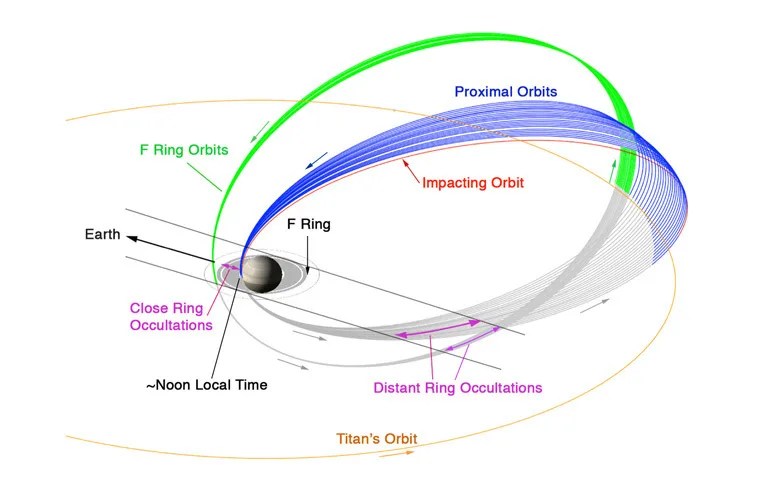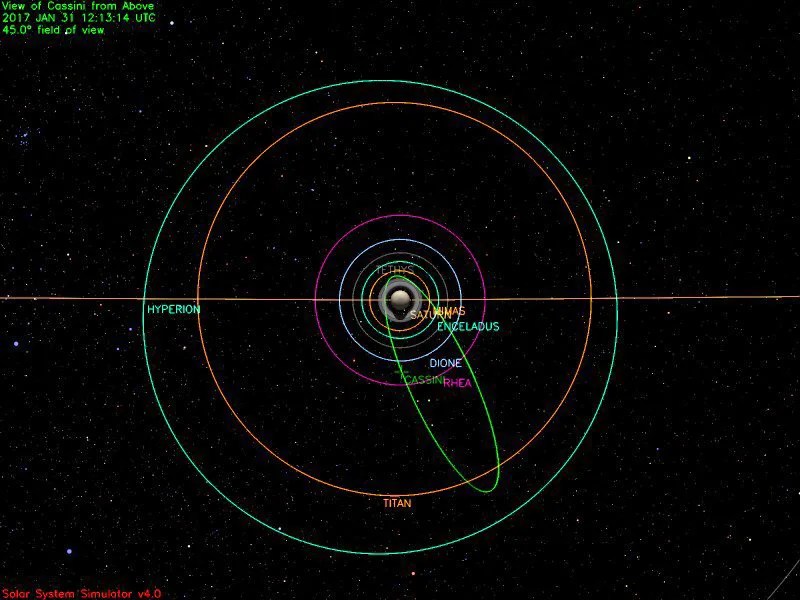6 min read

The images Cassini has been returning from the Saturn system have been remarkable in recent weeks, what with the close approaches to Saturn's rings and some of its moons. With each subsequent swoop near the ringed giant, its small inner moons, and rings, many observations have been from closer range than ever. But Saturn's invisible magnetosphere is also being investigated up close as never before, using instruments that directly measure the unseen conditions in their immediate environment, as well as at a distance. In all, much of the recent science returned from Cassini is unprecedented.
Wednesday, Jan. 25 (DOY 025)
A depiction of Cassini's current and future orbits of Saturn was selected as NASA's Astronomy Picture of the Day today: https://apod.nasa.gov/apod/ap170125.html . The spacecraft is currently following one of the F-ring (ring-grazing) orbits shown in green in the depiction. In fact, the nearly vertical green arrow on the right happens to be near Cassini's position today. When Titan meets up with Cassini on April 22, the gravitational interaction will cause the spacecraft to jump directly into the Grand Finale (Proximal) orbits shown in blue.
Cassini's ion and neutral mass spectrometer (INMS) and the Radio and Plasma Wave Science instrument (RPWS) surveyed Saturn's magnetosphere while the spacecraft continued its climb towards Friday's apoapsis. The Cosmic Dust Analyzer (CDA) devoted 5.5 hours to a search for an influx of meteors.
Next, the Imaging Science Subsystem (ISS) had the spacecraft turn to point its telescopes towards Saturn's small irregular moon Tarqeq for 3.4 hours. Tarqeq, a member of the Inuit group of irregular Saturn satellites, is about 6 kilometers in diameter and occupies an inclined orbit that reaches as far as 20.9 million km from Saturn. The Ultraviolet Imaging Spectrograph (UVIS) rode along to measure the object's albedo in ultraviolet light and learn about its surface microstructure and frost; the Visible and Infrared Mapping Spectrometer (VIMS) also rode along.
Finally, today, ISS turned to image Saturn's small, active moon Enceladus for nine hours, with VIMS and UVIS riding along. With the spacecraft just below Saturn's equatorial plane, the viewing geometry had Enceladus's south-polar plume lighted from behind by the Sun. A low-phase viewing angle like this means that the smallest of plume particles appear bright in the forward-scattered light.
Thursday, Jan. 26 (DOY 026)
Today's science activity comprised a 7.25-hour observation of another of Saturn's irregular moons, also a member of the Inuit group, with VIMS riding along. Small, dark-surfaced Paaliaq was the target. Named for a giant in Inuit mythology, this object is about 20 km in diameter, and occupies a highly inclined, highly elliptical orbit that reaches as far as 15.2 million km from the planet.
Friday, Jan. 27 (DOY 027)
ISS studied Tarqeq again today, with VIMS, for 6.3 hours. Next, ISS and VIMS observed Paaliaq again for seven hours. Cassini coasted through apoapsis during this activity, marking the start of Orbit #259.
Saturday, Jan. 28 (DOY 028)
ISS took the reins for 13.5 hours today to observe Saturn's irregular moon Albiorix. Named for the king of the world in Gallic mythology, this moon has a diameter of about 26 km and moves as far as 23.8 million km away from the planet, along an inclined, highly elliptical orbit. VIMS rode along.
Saturday, Jan. 29 (DOY 029)
ISS spent 90 minutes observing Saturn's planet-like moon Titan today, monitoring its weather with participation from CIRS and VIMS. Next came ISS observations of Paaliaq for nine hours, and Tarqeq for 1.3 hours. VIMS rode along with both.
The flight team uplinked part one of the S98 command sequence to Cassini today, using the 70-meter diameter Deep Space Network (DSN) station at Goldstone, California. After a round-trip light time of two hours and 58 minutes, telemetry showed that all 8,118 individual commands had been properly received and stored onboard. S98 will begin controlling Cassini's activities for 10 weeks on Feb. 3, as soon as S97 finishes executing.
Monday, Jan. 30 (DOY 030)
By now, Cassini had flown well north of Saturn's equator, and was in position to look "down" on Enceladus's north pole. ISS spent 2.6 hours observing, with the other Optical Remote-Sensing (ORS) instruments CIRS, UVIS, and VIMS riding along. This was the final opportunity in the mission to observe Enceladus’s northern pole. The viewing geometry is illustrated here.
Next, ISS looked "down" on Saturn's large icy moon Tethys for 1.4 hours, with the other ORS instruments riding. Following this, UVIS began 11 hours of scanning Saturn's northern auroral region, with CIRS and VIMS participating.
Four more ORS observations remained for the day, and all four ORS instruments participated in each one of them. First, ISS led the viewing of red streaks on Tethys for 35 minutes, and then turned to small Epimetheus when it was around 4,000 km away, for an observation lasting 110 minutes. This was Cassini's best-ever view of the little moon, which by the way trades its orbit with the larger moon Janus about every four years. Mimas was the next moon for ISS to view, and the observation lasted two hours.
The Mimas observation was the final one in the mission. During the observation, Cassini plunged through Saturn's ring plane, just outside the F ring again, for the ninth time. It sped through periapsis 20 minutes later. Finally, CIRS led a study of Enceladus, looking now at its south polar region for 8.6 hours.
With Cassini's ring-grazing orbits, a new window has opened on Saturn's rings, as illustrated in a news feature released today: /news/12993/close-views-show-saturns-rings-in-unprecedented-detail .
This 30-minute video captures a Facebook Live event in which today's visit to JPL's Mission Control room included questions and answers with the Cassini Project Scientist and a Spacecraft and Mission Planning Engineer: https://www.facebook.com/NASA/videos/10154861046561772 .
This image of Saturn's large icy moon Dione was featured today: /resources/17595 .
Tuesday, Jan. 31 (DOY 031)
CIRS and VIMS observed Saturn's big moon Rhea for five hours, and then ISS took over spacecraft pointing to view little Tarqeq again, for three hours with VIMS riding along.
The Cassini Project Scientist was interviewed today on The Planetary Society’s Planetary Radio podcast about Cassini’s final year, "The Final Countdown at Saturn": http://tiny.cc/27qwiy .
The DSN communicated with and tracked Cassini on 12 occasions this week, using stations at all three of the DSN's locations: Australia, California and Spain. A total of 21,964 individual commands were uplinked, and about 1,920 megabytes of telemetry data were downlinked and captured at rates as high as 110,601 bits per second.
Wrap up:
Cassini is executing its set of F-ring-grazing orbits of Saturn, with a period of 7.2 days in a plane inclined 63.7 degrees from the planet's equatorial plane. The 20 orbits are nearly identical, with Cassini's nearest point at about 150,000 km, and furthest point at about 1.28 million km from Saturn. Speeds relative to Saturn at those points (periapsis and apoapsis), are close to 76,150 km per hour and 9,000 km/h respectively.
The most recent spacecraft tracking and telemetry data were obtained on Jan. 31 using the 70-meter diameter DSN station in Spain. The spacecraft continues to be in an excellent state of health with all of its subsystems operating normally except for the instrument issues described at http://saturn.jpl.nasa.gov/anomalies .
The countdown clock in Mission Control shows 227 days until the end of the mission.
This illustration depicts Cassini's path up to mid-day Jan. 31, 2017.








